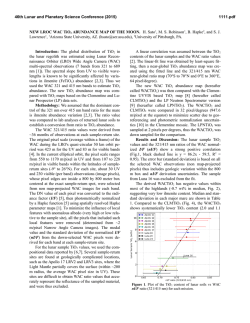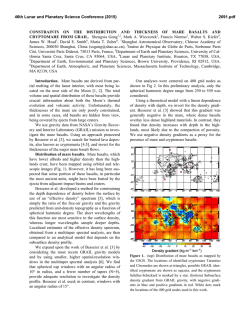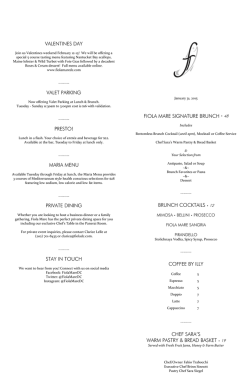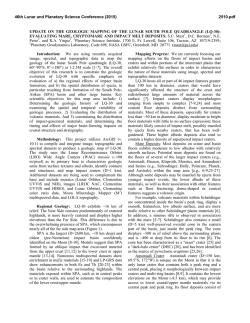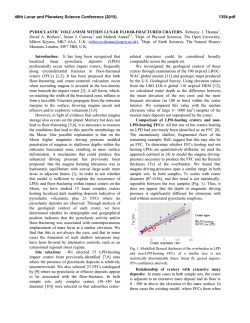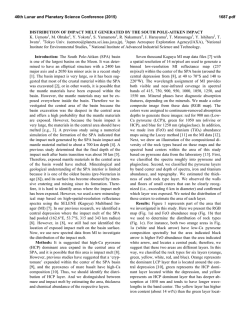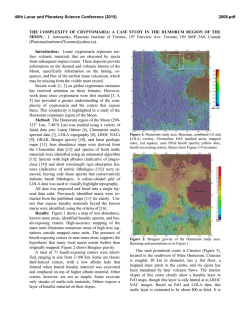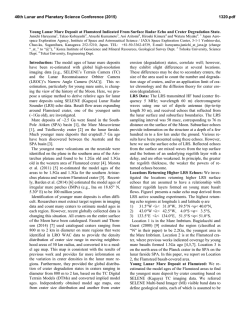
Characterizing Mare Deposits in the Australe Regione
46th Lunar and Planetary Science Conference (2015) 2739.pdf CHARACTERIZING MARE DEPOSITS IN THE AUSTRALE REGION. S. J. Lawrence1, J. D. Stopar1, B. L. Jolliff2, M. S. Robinson1, H. Sato1, H. Hiesinger3, B. R. Hawke4, T. A. Giguere4,5 1School of Earth and Space Exploration, Arizona State University, Tempe, AZ ([email protected]) 2Department of Earth and Planetary Sciences, Washington University in St. Louis, St. Louis, MO 3Institut für Planetologie, Westfälische Wilhelms-Universität Münster, Germany 4Hawaii Institute of Geophysics and Planetology, University of Hawaii, Honolulu, HI 5Integraph Corporation, Honolulu, HI Introduction: A key goal of the Lunar Reconnaissance Orbiter (LRO) second extended mission (ESM2) is to investigate volcanic processes at different temporal and physical scales including the identification and characterization of ancient (meaning: > 3.9 Ga) volcanic units. Mare Australe (a loosely-circular collection of mare basalts centered at approximately 38.9° S, 93° E) potentially includes ancient volcanic deposits and is a complex, extensive, and poorly understood volcanic region [1-5]. Background: Whitford-Stark [1] postulated four periods of mare eruptive activity from the late Nectarian to the Eratosthenian based on geologic mapping. Absolute model ages for a subset of basalt units in the Australe region range from 3.08-3.91 Ga [6]. Mare Australe has been proposed to lie within a pre-Nectarian impact basin [7-10], but does not have a well-defined basin rim boundary [11], thus the underlying cause of Mare Australe’s circularity is not yet understood. Fundamental information about the early stages of mare formation processes uncoupled from basin structure may be preserved in the discrete Australe basalt deposits, which each potentially represent one or several disconnected eruptive events. Goals: The goals of our study are to: 1) identify and characterize the discrete basalt deposits in the Australe region using new LRO data products, 2) identify possible basaltic source vents, and 3) further characterize mare stratigraphy and evolution of mare sources in the region. Previously, we reported preliminary work using new LRO data to understand the distribution of volcanic landforms and the extent of mare basalt exposures in the Australe region [4]. In this work, we determine new preliminary absolute model ages (AMAs) for a representative sampling of basalts, smooth plains, and cryptomaria in Australe, as well as characterize the physical parameters and compositions of these units using new data from LRO and legacy data from other lunar missions. Methods: This study uses new observations and data products from the Lunar Reconnaissance Orbiter, particularly the LRO Wide Angle Camera (WAC). The WAC is a push-frame camera capturing seven color bands (321, 360, 415, 566, 604, 643, and 689 nm) with a 57-km swath width in color mode and a 105-km swath width in monochrome mode from a 50-km altitude [12]. Primary data products employed in this investigation include the WAC global morphology base map, the GLD100 global topography dataset [13], and the recent Hapke parameter photometrically-corrected WAC color dataset of Sato et al. [14]. The GLD100 (spatial resolution sampling of 100 m and a vertical accuracy of 10m) is being used for all topographic measurements. The GLD100 was used to compute the Terrain Ruggedness Index (TRI), the mean elevation difference between the central DTM pixel and its surrounding cells, at a pixel scale of 100 m [15]. New crater size frequency distributions (CSFDs) for 44 surface units in the Australe region were collected and used to determine absolute model ages (AMAs) following the methods of Hiesinger et al. [16] applied to the WAC morphology base map. 23 of the count areas were the same as those used in Hiesinger et al. [6]. All craters larger than 1km in diameter identified in the LROC WAC global morphology base map were included in the counts. Individual landforms in the Australe region are being assessed using LRO Narrow Angle Camera (NAC) monoscopic observations. Five NAC Digital Terrain Models (DTMs) with pixel scales of 2m were used to investigate the topography and surface roughness characteristics of individual mare and highland units in the region. Finally, we used legacy datasets, including Clementine FeO and TiO2 maps of the Australe region produced using the techniques of [17] controlled to the WAC morphology basemap, and Th abundances extracted from the reduced half-degree Th dataset collected during the low-altitude portion of the Lunar Prospector mission [18], to characterize the composition of individual units. The boundaries of each deposit were based on those from Hiesinger et al. [6] and refined using the WAC color data of Sato et al. [14]. Taken collectively, these data products enable us to analyze the physical parameters and compositions of Australe units as a function of age. Results: Model Ages: The new AMAs determined for this study using LROC data are generally in good agreement with those previously reported [6]. Count regions included mare basalt exposures, smooth plains units, and prospective cryptomare. Our new AMAs for Australe basalt units are between 3.1 Ga and 4.1 Ga, 2739.pdf Basalt Units 8 7 6 5 4 3 2 1 0 Smooth Plains 2.5 Th (ppm) Frequency 46th Lunar and Planetary Science Conference (2015) 2 1.5 1 3 3.1 3.2 3.3 3.4 3.5 3.6 3.7 3.8 3.9 4 4.1 4.2 Absolute Model Age (Ga) Figure 2. Histogram of Absolute Model Ages determined for geologic units in the Australe region. spanning the Late Imbrian to the Pre-Nectarian epochs (Fig 1.). Topography: Mean equipotential surface elevations for the units characterized in this work range from 15m to –3770m. We discern no meaningful correlation between the AMAs and the elevations of the individual basalt units. GLD100 Morphometry: At the 100 m pixel scale of the GLD100, the TRI values for the basalt units in the Australe region range from 1.3 to 3.4, and are not correlated with the AMAs. NAC DTM Morphometry: Using NAC DTMs, we assessed the morphometry and surface roughness of three basalt units and a representative highlands unit near Hanno crater at the 2m/pixel scale of the NAC DTMs. At this pixel scale, the average TRI values of the three basalt units (0.14-0.18) are significantly less than the average highlands TRI (0.27). We are continuing to investigate the utility of NAC-derived morphometric parameters such as the TRI in quantitatively identifying and mapping the extents of cryptomare and/or smooth plains units. For this purpose, additional NAC geometric stereo observations are being acquired of cryptomaria and other potential volcanic landforms in the Australe region. Composition: FeO values for the soils developed on mare deposits vary between 11 and 15 weight %. TiO2 values vary between 0.7 to 3.8 weight %, compositions that likely reflect nonmare contamination [e.g., 19]. No strong correlation between the AMAs and the FeO and TiO2 content were observed. Th concentrations for the basalt units are between 1.5 and 2.5 ppm Th (Fig. 2), and are largely indistinguishable from nonmare Th concentrations in the Australe region. Three of the units with AMA values of 3.13.3 Ga have elevated Th values, but all other units investigated in this study (including smooth plains units) have values between 1.5 and 2 ppm. Thus, there is also no strong relationship between the model age and Th abundance. 3 3.5 4 4.5 Model Age (Ga) Figure 1. Th abundances of geologic units in the Australe region. Implications: The lack of temporal and spatial correlations between compositions, morphometric parameters, and ages of deposits in the Australe region suggests that the various basalt units in the Australe region have tapped discrete but not highly variable mantle source regions, as suggested by Gillis and Jolliff [3]. The relatively low abundances of Th when compared to the PKT mare units [20] and farside Th anomalies like Dewar [21] and Compton-Belkovich [22], provides evidence that the distribution of KREEP elements including Th in the mantle is discontinuous and nonuniform, but in the Australe region there appears to have been no significant fluctuation with time. Acknowledgements: This work is supported by the LRO mission. References: [1] J. L. Whitford-Stark (1979) Proc. LPSC 10, pp. 2975–2994. [2] I. Antonenko et al. (1995) Earth Moon Planets, 69, 2, pp. 141–172 [3] J. J. Gillis and B. L. Jolliff (2002) in The Moon Beyond 2002, p. 18. [4] S. J. Lawrence et al. (2013) LPSC 44, Abs. 2671. [5] Whitten J. L. and Head J. W. (2015) Icarus doi:10.1016/j.icarus.2014.09.031 [6] Hiesinger et al. (2000) JGR Planets, doi:10.1029/2000JE001244 [7] J. J. Gillis (1998) PhD Dissertation, Rice University, Houston, TX [8] D. E. Stuart-Alexander and K. A. Howard (1970) Icarus, 12, 3, pp. 440–456. [9] P. D. Spudis (1995) Meteoritics, 30, 582. [10] D. E. Wilhelms (1987) USGS Prof. Pap. 1348. [11] H. Frey (2011) GSA Spec. Pap. 477, pp. 53-75. [12] M. S. Robinson et al. (2010) Space Sci. Rev., 150, 1–4, 81–124. [13] F. Scholten et al. (2012) JGR Planets, 117, E12, E00H17. [14] H. Sato et al. (2014) JGR Planets, doi:10.1002/2013JE004580. [15] M. F. J. Wilson (2007) Mar. Geod., 30, 1–2, 3–35. [16] H. Hiesinger et al. (2011) GSA Spec. Pap., 477, pp 1-51. [17] P. G. Lucey et al. (2000) JGR Planets, 105, E8, 20297–20305. [18] D. J. Lawrence et al. (2003) JGR Planets, 108, E9, 5102. [19] Korotev R. L. and Gillis J. J. (2001) JGR Planets, 106, 12, 339 [20] Jolliff B. L. et al. (2000) JGR Planets, doi:10.1029/1999JE001103 [21] Lawrence S. J. et al. (2008) JGR Planets, doi:10:1029/2007JE002904 [22] Jolliff B. L. et al. (2011) Nat. Geo., doi:10.1038/ngeo1212.
© Copyright 2025
